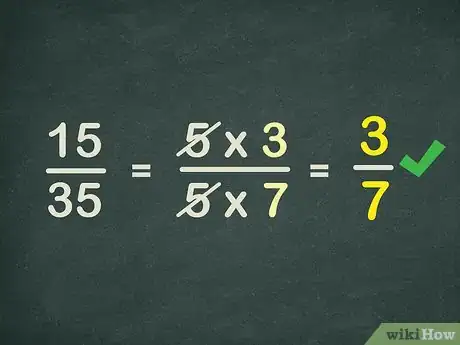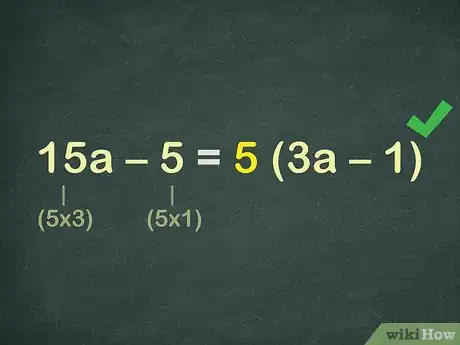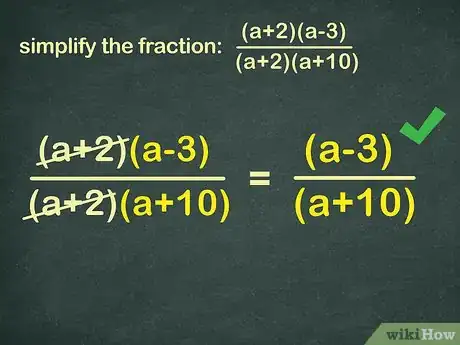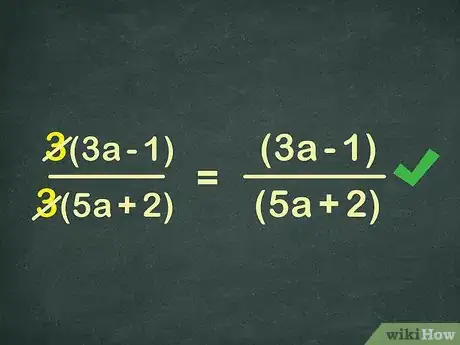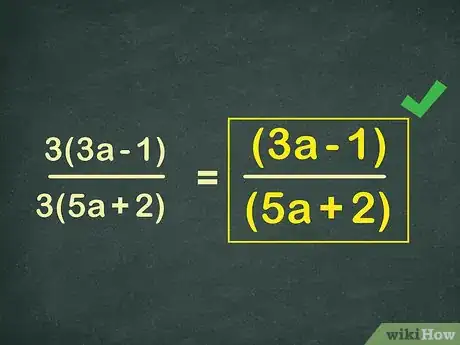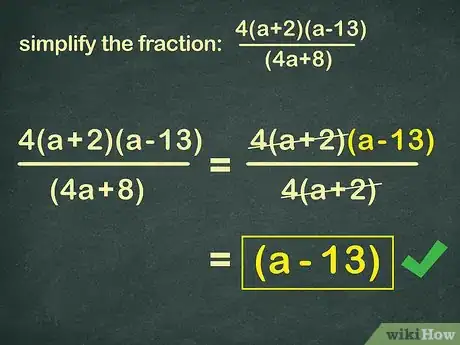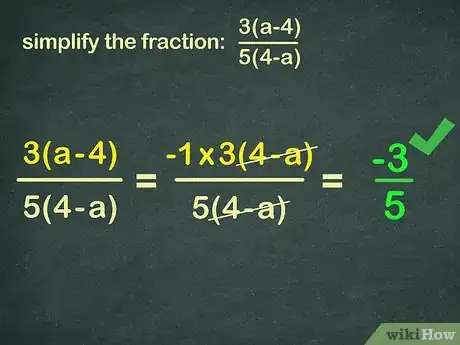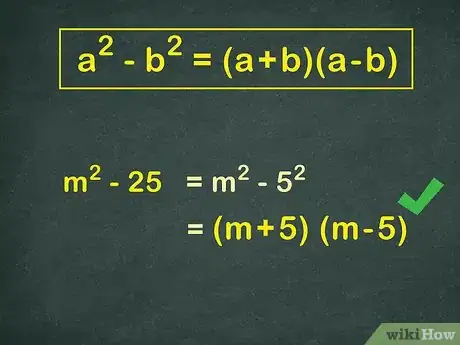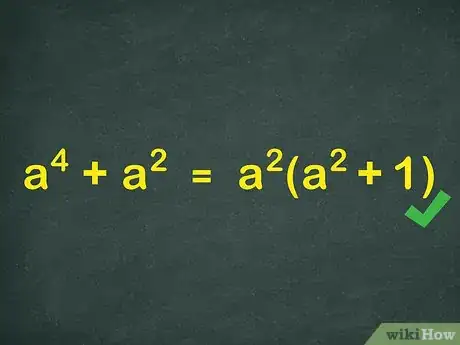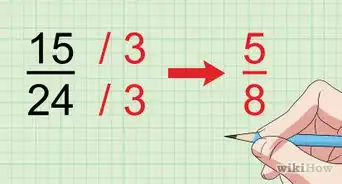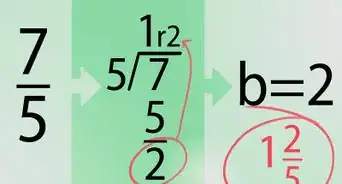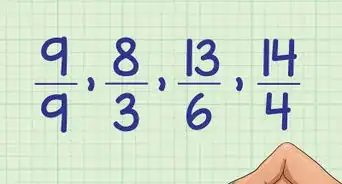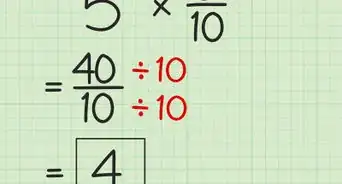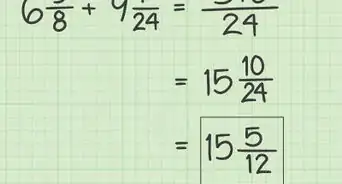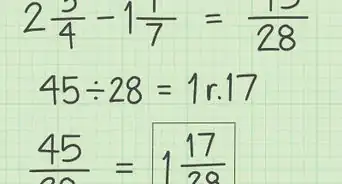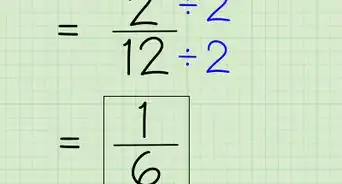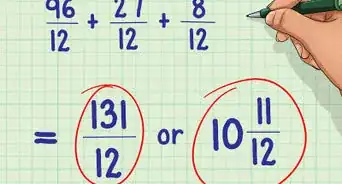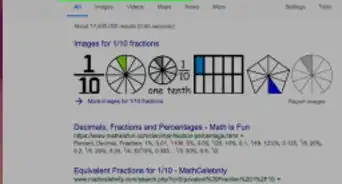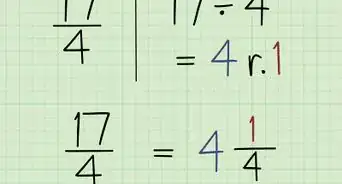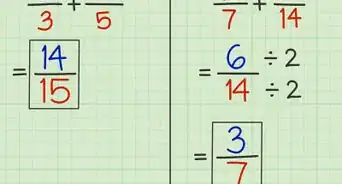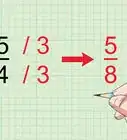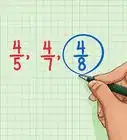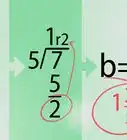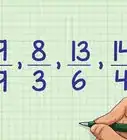This article was co-authored by David Jia. David Jia is an Academic Tutor and the Founder of LA Math Tutoring, a private tutoring company based in Los Angeles, California. With over 10 years of teaching experience, David works with students of all ages and grades in various subjects, as well as college admissions counseling and test preparation for the SAT, ACT, ISEE, and more. After attaining a perfect 800 math score and a 690 English score on the SAT, David was awarded the Dickinson Scholarship from the University of Miami, where he graduated with a Bachelor’s degree in Business Administration. Additionally, David has worked as an instructor for online videos for textbook companies such as Larson Texts, Big Ideas Learning, and Big Ideas Math.
This article has been viewed 121,169 times.
Algebraic fractions look incredibly difficult at first, and can seem daunting to tackle for the untrained student. With a mixture of variables, numbers, and even exponents, it is hard to know where to begin. Luckily however, the same rules needed to simplify regular fractions, like 15/25, still apply to algebraic fractions.
Steps
Simplifying Fractions
-
1Know the vocabulary for algebraic fractions. The following terms will be used throughout the examples, and are common in problems involving algebraic fractions:[1]
- Numerator: The top part of a fraction (ie. (x+5)/(2x+3)).
- Denominator: The bottom part of the fraction (ie. (x+5)/(2x+3)).
- Common Denominator: This is a number that you can divide out of both the top and bottom of a fraction. For example, in the fraction 3/9, the common denominator is 3, since both numbers can be divided by 3.
- Factor: One number that multiples to make another. For example, the factors of 15 are 1, 3, 5, and 15. The factors of 4 are 1, 2, and 4.
- Simplified Equation: This involves removing all common factors and grouping similar variables together (5x + x = 6x) until you have the most basic form of a fraction, equation, or problem. If you cannot do anything more to the fraction, it is simplified.
-
2Review how to solve simple fractions. These are the exact same steps you will take to solve algebraic fractions.[2] Take the example, 15/35. In order to simplify a fraction, we need to find a common denominator. In this case, both numbers can be divided by five, so you can remove the 5 from the fraction:
15 → 5 * 3
35 → 5 * 7
Now you can cross out like terms. In this case you can cross out the two fives, leaving your simplified answer, 3/7.Advertisement -
3Remove factors from algebraic expressions just like normal numbers.[3] In the previous example, you could easily remove the 5 from 15, and the same principle applies to more complex expressions like, 15x – 5. Find a factor that both numbers have in common. Here, the answer is 5, since you can divide both 15x and -5 by the number five. Like before, remove the common factor and multiply it by what is “left.”
15x – 5 = 5 * (3x – 1) To check your work, simply multiply the five back into the new expression – you will end up with the same numbers you started with. -
4Know you can remove complex terms just like simple ones. The same principle used in common fractions works for algebraic ones as well. This is the easiest way to simplify fractions while you work.[4] Take the fraction:
(x+2)(x-3)
(x+2)(x+10)
Notice how the term (x+2) is common in both the numerator (top) and denominator (bottom). As such, you can remove it to simplify the algebraic fraction, just like you removed the 5 from 15/35:(x+2)(x-3) → (x-3)(x+2)(x+10) → (x+10)
Simplifying Algebraic Fractions
-
1Find a common factor in the numerator, or top part of the fraction. The first thing to do when simplifying an algebraic fraction is to simplify each part of the fraction. Start with the top part, factoring out as many numbers as you can.[5] For an example, this section will use the problem:
9x-3
15x+6
Start with the numerator: 9x – 3. There is a common factor to both 9x and -3: 3. Factor out the 3 like you would any other number, leaving you with 3 * (3x-1). This is your new numerator:3(3x-1)
15x+6 -
2Find a common factor in the denominator.[6] Continuing the example from above, isolate the denominator, 15x+6. Again, look for a number that can divide into both parts. Here you can again factor out a 3, leaving you with 3 * (5x +2). Write in your new denominator:
3(3x-1)
3(5x+2) -
3Remove like terms. This is the stage where you really get to simplify the fraction. Take any terms that are in both the numerator and the denominator and remove them. In this case, we can remove the 3 from both the top and the bottom.[7]
3(3x-1) → (3x-1)3(5x+2) → (5x+2) -
4Know when the equation is fully simplified. A fraction is simplified when there are no more common factors in the top or the bottom.[8] Remember that you cannot remove factors from inside the parenthesis – in the example problem you cannot factor out the x from 3x and 5x, since the full terms are actually (3x -1) and (5x + 2). Thus, the example is fully simplified, making the final answer:
(3x-1)
(5x+2) -
5Try a practice problem. The best way to learn is to keep trying to simplify algebraic fractions. The answers are underneath the problems.
4(x+2)(x-13) Answer: (x=13)
(4x+8)2x2-x Answer:(2x-1)/5
5x
Tricks for Difficult Problems
-
1”Reverse” parts of the fraction by factoring out negative numbers. For example, let’s say we have the equation:
3(x-4)
5(4-x)
Notice how (x-4) and (4-x) are ‘’almost’’ identical, but you can’t cross them out because they are reversed. However, (x - 4) can be written as -1 * (4 - x) in the same way that you rewrite (4 + 2x) as 2 * (2 + x). This is called “factoring out the negative.”-1 * 3(4-x)
5(4-x)
Now we can easily remove the two identical (4-x):-1 * 3 (4-x)
5(4-x)
Leaving us with our final answer -3/5 -
2Recognize the difference of two squares when working. The difference of two squares is simply one squared number subtracted by another, like the expression (a2 - b2). The difference of perfect squares always simplifies into two parts, adding and subtracting the square roots. In every case, you can simplify the difference of perfect square as follows:
a2 - b2 = (a+b)(a-b) This can be incredibly helpful when trying to find like terms in algebraic fractions.- Example: x2 - 25 = (x+5)(x-5)
-
3Simplify any polynomial expressions. Polynomials are complex algebraic expressions with more than two terms, like x2 + 4x + 3. Luckily, many polynomials can be simplified using polynomial factorization. The previous expression, for example, can be rewritten as (x+3)(x+1).
-
4Remember that variables can be factored out as well. This is especially helpful in expressions with exponents, like x4 + x2. You can remove the largest exponent as a factor. In this case, x4 + x2 = x2(x2 + 1).
Community Q&A
-
QuestionWhy does it work exactly like this all the time?
 DonaganTop AnswererBecause the properties of and operations with numbers never change.
DonaganTop AnswererBecause the properties of and operations with numbers never change. -
QuestionWhen factoring algebraic fractions, how do I know which one will have a plus or minus sign? For example, 12x^2 + 43x+ 35 / 6x^2 +5x - 21?
 DonaganTop AnswererThis is known as "solving by inspection." In other words, you just look at ("inspect") the expression you're factoring, and choose plus and minus signs so that the factors, when multiplied together, result in the original expression. In the example cited, 12x² + 43x +35 factors into (3x + 7) and (4x + 5). 6x² + 5x - 21 factors into (3x + 7) and (2x - 3). In each case the signs were chosen so that multiplying the factors together would result in the original expression. In this case there is a factor of (3x + 7) in both the numerator and denominator, so that they cancel each other. The final, simplified expression is (4x + 5) / (2x - 3).
DonaganTop AnswererThis is known as "solving by inspection." In other words, you just look at ("inspect") the expression you're factoring, and choose plus and minus signs so that the factors, when multiplied together, result in the original expression. In the example cited, 12x² + 43x +35 factors into (3x + 7) and (4x + 5). 6x² + 5x - 21 factors into (3x + 7) and (2x - 3). In each case the signs were chosen so that multiplying the factors together would result in the original expression. In this case there is a factor of (3x + 7) in both the numerator and denominator, so that they cancel each other. The final, simplified expression is (4x + 5) / (2x - 3). -
QuestionWhat if there's a question like this: (1–y²) / (–y² – y + 2)?
 DonaganTop AnswererFirst simplify a little by factoring (-1) from both numerator and denominator: -(y²-1) / -(y²+y-2). The (-1)'s will cancel each other, and you're left with (y²-1) / (y²+y-2). Factor numerator and denominator: [(y+1)(y-1)] / [(y+2)(y-1)]. The two (y-1)'s cancel each other, and the final fraction is (y+1) / (y+2).
DonaganTop AnswererFirst simplify a little by factoring (-1) from both numerator and denominator: -(y²-1) / -(y²+y-2). The (-1)'s will cancel each other, and you're left with (y²-1) / (y²+y-2). Factor numerator and denominator: [(y+1)(y-1)] / [(y+2)(y-1)]. The two (y-1)'s cancel each other, and the final fraction is (y+1) / (y+2).
Warnings
- Forget the laws of indices, and you're dead meat. Therefore, stuff them into your brain at all costs.⧼thumbs_response⧽
References
- ↑ https://www.mathematics-monster.com/glossary/algebraic_fractions.html
- ↑ https://www.mathsisfun.com/simplifying-fractions.html
- ↑ https://www.bbc.com/bitesize/guides/zmvrd2p/revision/1
- ↑ https://www.purplemath.com/modules/rtnldefs2.htm
- ↑ https://www.bbc.co.uk/bitesize/guides/zwv9y4j/revision/1
- ↑ https://virtualnerd.com/pre-algebra/factors-fractions-exponents/simplify-fractions/simplify-algebraic-fractions/simplify-algebraic-fraction-common-factors
- ↑ https://virtualnerd.com/pre-algebra/factors-fractions-exponents/simplify-fractions/simplify-algebraic-fractions/simplify-algebraic-fraction-common-factors
- ↑ https://virtualnerd.com/pre-algebra/factors-fractions-exponents/simplify-fractions/simplify-algebraic-fractions/simplify-algebraic-fraction-common-factors
About This Article
To simplify algebraic fractions, start by factoring out as many numbers as you can for the numerator, which is the top part of the fraction. Next, find a common factor in the denominator, which is the bottom part of the fraction, by looking for a number that can divide into both parts. Then, take any terms that are in both the numerator and the denominator and remove them. When there are no more common factors in the top or the bottom, the fraction is simplified! For more tips on factoring, read on!

